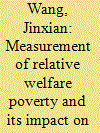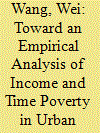|
|
|
Sort Order |
|
|
|
Items / Page
|
|
|
|
|
|
|
| Srl | Item |
| 1 |
ID:
159809


|
|
|
|
|
| Summary/Abstract |
This article examines the nature of spatial dimensions of poverty in Bangladesh by undertaking an in-depth investigation of inter-temporal divergence and convergence in poverty levels. Based on the estimations of Alkire–Foster Multidimensional Poverty Index (A–F MPI) for selected years, the article compares trends in broader dimensions of spatial poverty in Bangladesh with income poverty trends available for corresponding periods. The article scrutinizes the validity of the so-called ‘East–West divide’ in view of poverty levels in Bangladesh. The results evince a number of interesting insights. First, trends of income poverty in Bangladesh are not aligned with those of multidimensional poverty. Second, the levels of inter-temporal poverty as per MPI are relatively higher for the rural–urban divide and also at sub-national (division) levels. Third, inter-temporal trends of divergence–convergence in terms of income poverty relating to the East–West divide do not match corresponding movements in MPI. It is argued that while income poverty dimensions remain important, policymakers should pay more attention to broader issues of deprivations to address challenges of poverty in Bangladesh. Therefore, addressing causes of deprivations as captured in MPIs will help achieve balanced spatial development, accelerated poverty reduction and lower income inequality in Bangladesh.
|
|
|
|
|
|
|
|
|
|
|
|
|
|
|
|
| 2 |
ID:
159063


|
|
|
|
|
| Summary/Abstract |
This paper aims to study on the precise identification and targeting of immigrant poverty in the TGRR, with a multi-dimensional poverty line as a standard, which has transcended the traditional income poverty line. Then, we figured out the changing trend and the causes of immigrant poverty under the perspective of multidimensional poverty. Based on the dual cutoff method and regression analysis, the study results show that the discrepancy of poverty before and after immigration is significant, but the poverty problem of immigrants in the TGRR is still serious. The current multi-poverty incidence of immigrants is 30.15%, which means that there are still 2.3097 million people under poverty. The major causes of poverty in this region are poverty in assets, poverty in education and poverty in health. The poverty contribution rate of land scarcity has increased from 12.16% to 29.52% with the deterioration of land loss, which has a negative effect on immigrants' livelihood. The results reveal several outstanding poverty problems in this region: the coverage of social security of immigrants is far from ideal; There are still 12.75% of the impoverished immigrants without medical insurance and 11.36% without pension insurance; the percentage of female laborers, the education level of laborers, the percentage of agricultural expenditure and the percentage of medical expenditure have significant correlations with immigrants' poverty in this region. The paper argues that the precise identification and targeting of poverty reduction in China should be undertaken from a multidimensional perspective.
|
|
|
|
|
|
|
|
|
|
|
|
|
|
|
|
| 3 |
ID:
182810


|
|
|
|
|
| Summary/Abstract |
Individual or household income has been the conventional yardstick of poverty. Presently, non-income factors are universally accepted as measures of poverty. Attention on the multiple dimensions of poverty and their policy implications has been growing in the past 20 years. However, few studies have analyzed relative multidimensional poverty, especially in China. Moreover, the relationship between relative welfare poverty and happiness has been rarely studied, particularly given that the decline of poverty seemed not bringing a significant increase in happiness in China. This research gap is noteworthy because enhancing the subjective well-being of the people is crucial to a nation's sustainable economic development. On the basis of the micro-level data from China General Social Survey, this study puts forward a welfare approach to analyzing the relative multidimensional poverty and then determines the link between relative welfare poverty and individual happiness. Our results show that 1) relative welfare poverty has not declined significantly and 2) there is a significantly happiness-reducing effect of relative welfare poverty.
|
|
|
|
|
|
|
|
|
|
|
|
|
|
|
|
| 4 |
ID:
110508


|
|
|
|
|
| Publication |
2011.
|
| Summary/Abstract |
Most studies have reported non negligible improvements for China in terms of poverty during the last three decades. However, this result is potentially hampered by two limitations. First, it may be contingent to the specific choices made regarding the poverty line and the poverty indices used for the analysis. As a consequence, it may collapse if one uses alternative poverty lines or poverty measures. Second, it results from a focus on the sole monetary aspects of poverty. As income does not cover all facets of well-being and since the relationship between these two concepts are quite fuzzy, it may be worth using a broader view of well-being, hence opting for a multidimensional approach of poverty analysis. In the present paper, these two issues are addressed using multidimensional stochastic dominance procedures on the joint distribution of income, education and health in seven Chinese provinces.
|
|
|
|
|
|
|
|
|
|
|
|
|
|
|
|
| 5 |
ID:
133099


|
|
|
|
|
| Publication |
2014.
|
| Summary/Abstract |
The multidimensionality of poverty is often neglected at the policy-formulation stage in developing countries. As need priorities of local poor vary across countries and within regions of the same country, an understanding of finely tuned poverty indicators should be the starting point in formulating country-specific poverty-reduction strategies. By reviewing cross-country studies and existing poverty literature, this paper demonstrates the construction of a multidimensional poverty model to better inform poverty listing in the case of Bangladesh.
|
|
|
|
|
|
|
|
|
|
|
|
|
|
|
|
| 6 |
ID:
188931


|
|
|
|
|
| Summary/Abstract |
Many earlier studies have assessed Chinese poverty using monetary dimensions, but few have considered the time dimension. This research investigates multidimensional poverty in urban China, using data from the 2013 China Household Income Project, from the standpoints of income and time. A logistic regression model was used to estimate the socioeconomic causes of income poverty, time poverty, and income–constrained time poverty. Empirical results obtained from this study reveal that being a paid female worker or a private enterprise employee and bearing the financial burdens of housing and medical care have significant effects on the probability of being time poor. In addition, workers who have low academic achievement, children, and educational loans are particularly prone to suffering income–constrained time poverty. This study contributes to the assessment of severe poverty situations and suggests an increasing need for working time regulations and more support for less-educated workers in urban China.
|
|
|
|
|
|
|
|
|
|
|
|
|
|
|
|
|
|
|
|
|